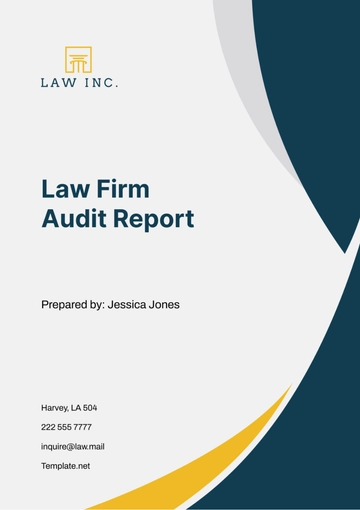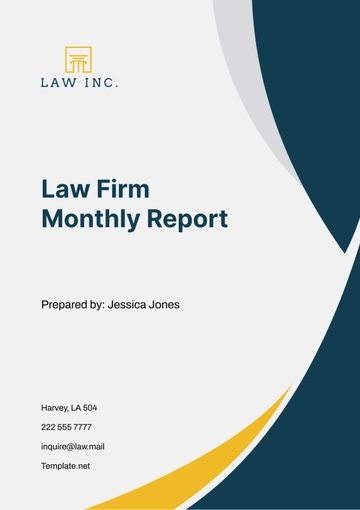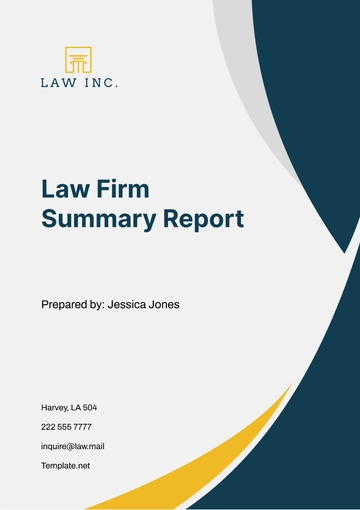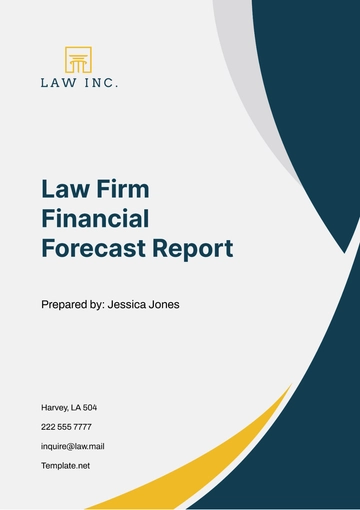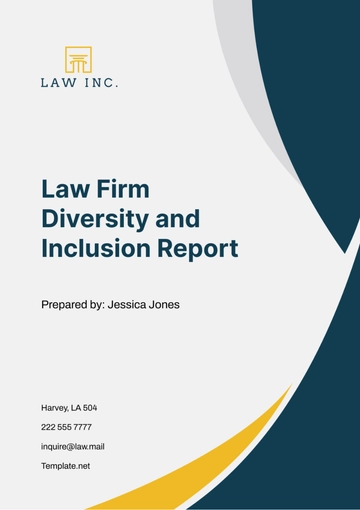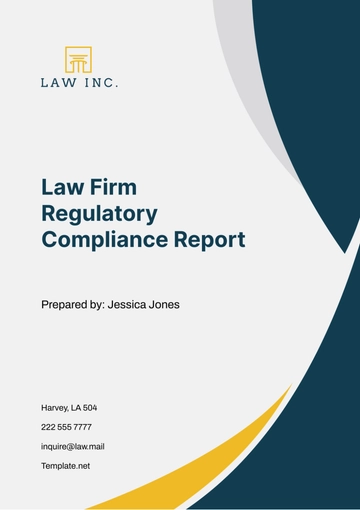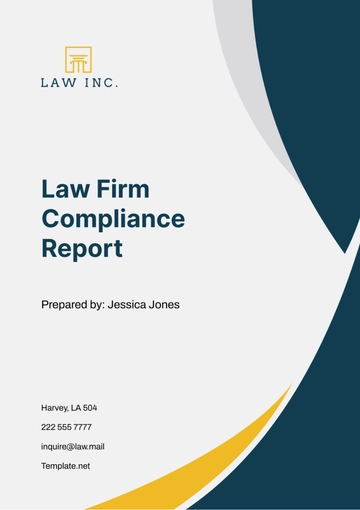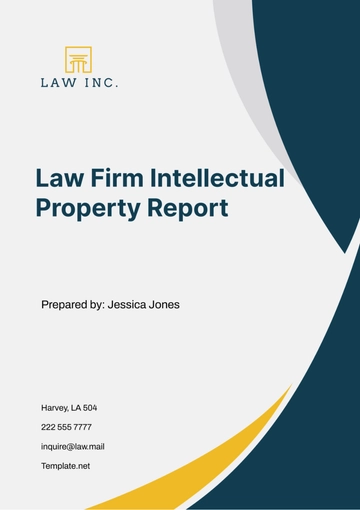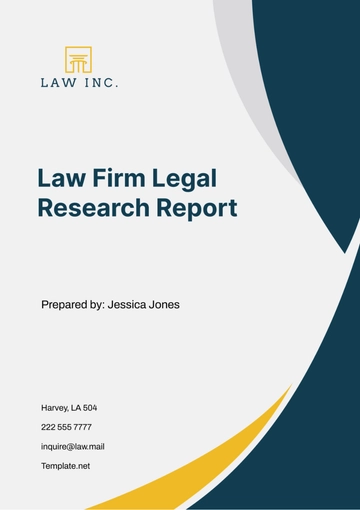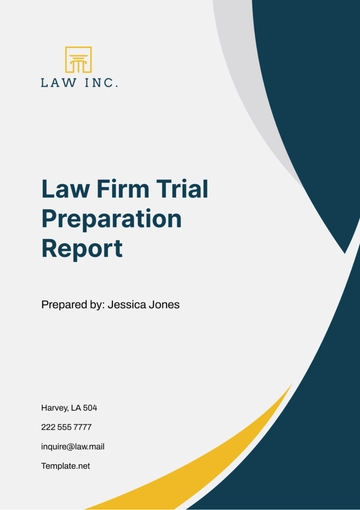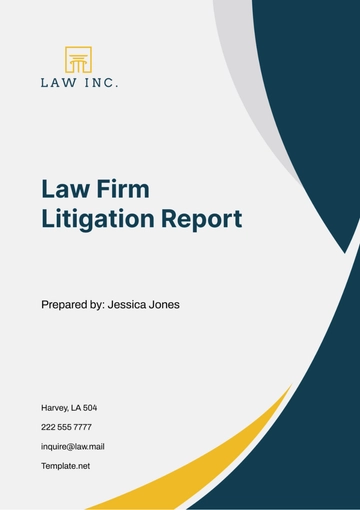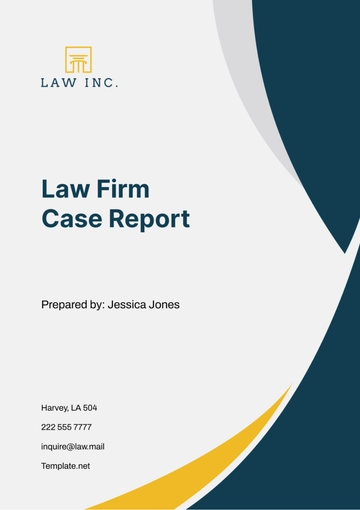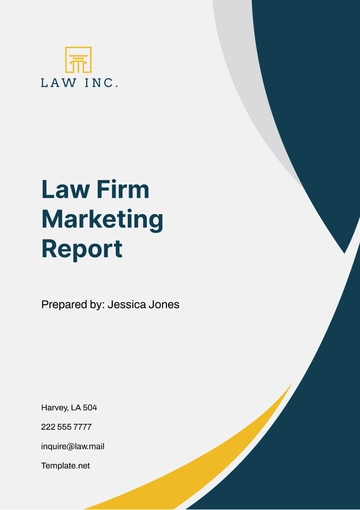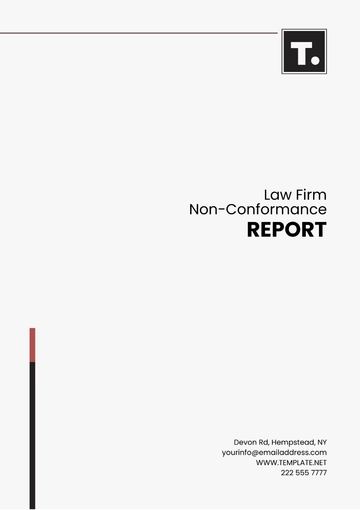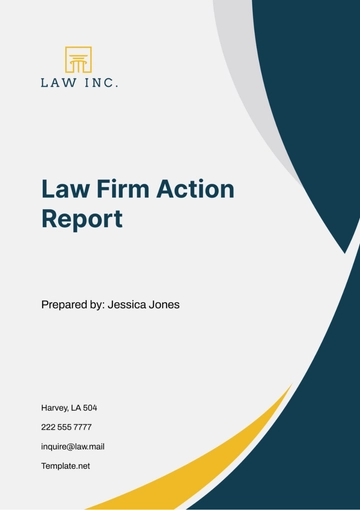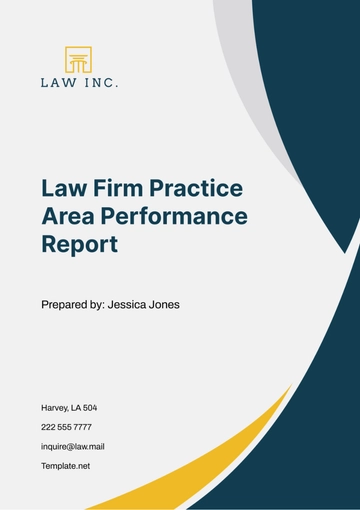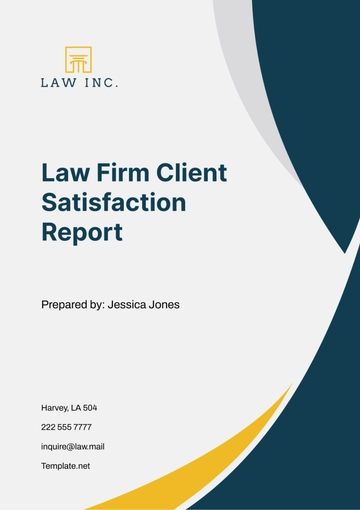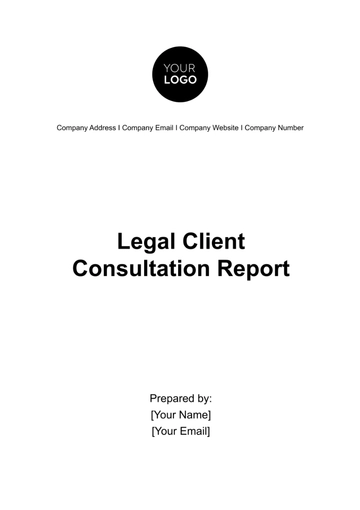Free Law Firm Regulatory Compliance Report

1. Executive Summary
This compliance report for [Your Company Name] aims to assess our adherence to applicable laws and regulations that impact our operations. The review was conducted over the quarter ending [Insert Date], encompassing a broad range of compliance areas including data protection, anti-money laundering (AML), client funds management, professional responsibility, and employment laws.
Key findings suggest that while the firm shows strong compliance in areas such as client funds management and professional responsibility, there are significant areas requiring improvement, particularly in data protection and AML practices. Recommendations are provided to address these deficiencies, alongside strategies to bolster our overall compliance framework.
2. Introduction
Purpose of the Report
The primary objective of this report is to evaluate [Your Company Name]'s adherence to the regulatory standards that govern our practice. This analysis aims to identify strengths and areas of risk, provide actionable recommendations, and support the firm in maintaining the highest standards of legal compliance.
Scope of the Compliance Review
This review is wide-ranging in its scope, aiming to include all primary aspects of regulatory compliance that are significant to the functioning of our operations. This not only covers the regulations that directly influence us but also spans every jurisdiction where we currently carry out our operations. The intent is to ensure that we remain in compliance with all the relevant regulations, irrespective of the jurisdiction in which we are operating.
Methodology
Our methodology involved a review of current firm policies, interviews with key personnel, audits of our client files, and a detailed examination of our case management systems. Compliance with both local and international regulations was assessed.
3. Regulatory Environment
Understanding the regulatory environment is crucial for navigating the complexities of legal compliance effectively. Below is an overview of the key legal and regulatory frameworks applicable to our operations, recent legal changes, and anticipated future trends.
Relevant Legal and Regulatory Frameworks
Our firm operates under several important regulatory frameworks that impact various aspects of our legal practice. Here's a summary:
Regulation | Jurisdiction | Description |
|---|---|---|
General Data Protection Regulation (GDPR) | European Union | Protects data privacy and personal data across EU countries. |
USA PATRIOT Act | United States | Enhances domestic security and broadens surveillance powers to prevent terrorism. Includes significant provisions on money laundering prevention. |
Bank Secrecy Act (BSA) | United States | Requires financial institutions to assist government agencies to detect and prevent money laundering. |
Local Bar Association Ethical Rules | Various | Governs professional conduct and responsibilities of lawyers within their respective jurisdictions. |
Future Regulatory Trends and Implications for the Firm
Anticipating future regulatory changes is critical for proactive compliance planning. Here's what we expect and how it may impact our operations:
Anticipated Regulation | Expected Impact |
|---|---|
Digital Privacy Enhancements | Stricter control and security measures for handling digital client information. |
International AML Standards Update | Harmonization of AML practices across borders, increasing compliance requirements for multinational operations. |
Changes in Employment Law (Remote Work) | New standards for managing remote employees, potentially affecting employment contracts and HR policies. |
4. Firm Overview
Firm Profile
[Your Company Name] is a full-service law firm with over 500 employees, operating across three countries. We specialize in corporate law, intellectual property, and litigation.
Organizational Structure
Our compliance responsibilities are distributed as follows:
Role | Responsibilities |
|---|---|
Compliance Officer | Oversight of all compliance activities |
Data Protection Officer | Ensuring data privacy and security |
Finance Director | Management of client funds and accounts |
5. Compliance Areas
Data Protection and Privacy
Our audit revealed several areas for improvement in data handling practices, specifically regarding the personal data of clients and employees. Current measures include basic encryption and consent mechanisms, but gaps in data minimization and storage limitation practices were noted. An assessment of our compliance with the General Data Protection Regulation (GDPR) and other local data protection laws revealed a compliance level of approximately 75%. Specific issues included outdated privacy notices and insufficient employee training on data breach response.
Key Actions:
Update privacy policies and procedures to reflect recent legal changes.
Increase frequency and depth of staff training on data protection.
Implement advanced encryption methods for sensitive client data.
Anti-Money Laundering (AML)
The firm has established client identity verification processes and transaction monitoring systems. However, the review identified inconsistencies in the application of these processes, particularly in high-risk scenarios. Our compliance with AML regulations is currently at 65%, with deficiencies noted in the ongoing monitoring and reporting of suspicious activities.
Key Actions:
Standardize AML procedures across all departments to ensure consistency.
Deploy enhanced transaction monitoring software.
Regularly update AML training programs to include recent developments and case studies.
Client Funds Management
The management of client funds is a critical area with a high compliance rate of 95%. Our firm uses segregated accounts for client funds and adheres strictly to bar association guidelines. However, minor issues related to timely reconciliation processes were identified.
Key Actions:
Improve the frequency and methods of reconciliation of client accounts.
Conduct quarterly audits to ensure compliance with all regulations and guidelines.
Professional Responsibility and Ethics
This area is a strength for the firm, with a compliance rate of 98%. Procedures are in place to handle conflicts of interest, and all attorneys adhere to strict ethical guidelines. Nonetheless, there is room for improvement in documenting and reporting decisions related to ethical dilemmas.
Key Actions:
Develop a more robust internal reporting system for ethical issues.
Enhance documentation procedures to ensure transparent decision-making processes.
Employment Law
Our firm is compliant with 90% of employment laws following recent updates to our employee handbook and benefits policies. Areas for improvement include the handling of freelance and remote workers under new labor laws.
Key Actions:
Review and revise policies to include provisions for remote and freelance workers.
Increase legal updates and training sessions on employment law changes for HR staff.
6. Risk Assessment
Our risk assessment framework identifies potential compliance risks and evaluates their impact and likelihood. Key risks identified include data breaches and non-compliance with AML directives due to inadequate training.
Risk Category | Potential Impact | Likelihood |
|---|---|---|
Data Breach | High | Medium |
AML Non-Compliance | High | High |
Current Risk Management Strategies
Current strategies include regular training sessions, audit checks, and a dedicated compliance team. However, improvements are needed in the areas of continuous monitoring and incident response plans.
7. Compliance Performance
Comprehensive reviews were conducted across the identified compliance areas. Here are the detailed findings:
Data Protection and Privacy: Several data breaches were avoided last year due to our proactive measures. However, audit trails showed delayed responses in some instances, emphasizing the need for faster detection and response mechanisms.
Anti-Money Laundering (AML): Feedback from compliance officers indicates that new hires often lack a deep understanding of AML requirements, suggesting an improvement in our training programs is necessary.
Client Funds Management: Audits reveal high compliance, with isolated incidents of delayed transaction processing. Continued vigilance is necessary to maintain trust and integrity.
Professional Responsibility and Ethics: A few reports of ethical concerns were noted, with all resolved satisfactorily. However, the processes for handling these reports can be made more robust and transparent.
Employment Law: Compliance is strong, but upcoming changes in employment legislation will require adjustments to our policies, especially regarding non-traditional employment arrangements.
Feedback and Improvements: Interviews with staff across departments revealed a desire for more frequent updates on regulatory changes and a clearer understanding of compliance roles and responsibilities.
8. Recommendations
Based on our findings, the following strategic recommendations are proposed:
Enhance Data Security: Implement state-of-the-art cybersecurity measures including better encryption and real-time monitoring tools.
Strengthen AML Compliance: Introduce advanced software for monitoring and reporting, and regularize AML training sessions.
Fortify Client Funds Oversight: Introduce automated tools for quicker and error-free transaction processing.
Bolster Ethical Practices: Create a more transparent system for reporting and resolving ethical issues.
Update Employment Practices: Proactively adapt policies to reflect changes in employment laws, focusing on inclusivity and flexibility.
9. Conclusion
This report demonstrates [Your Company Name]'s commitment to maintaining the highest standards of compliance. Addressing the identified gaps will not only improve our firm’s regulatory stance but also enhance our operational efficiency and reputation in the legal community. By implementing the recommended actions, we can ensure continued legal compliance and set a standard for best practices within the industry.
- 100% Customizable, free editor
- Access 1 Million+ Templates, photo’s & graphics
- Download or share as a template
- Click and replace photos, graphics, text, backgrounds
- Resize, crop, AI write & more
- Access advanced editor
Stay ahead of regulations with Template.net's Law Firm Regulatory Compliance Report Template. Designed for meticulous oversight, this template is fully customizable and editable via our Ai Editor Tool. Track and document compliance with all legal standards, ensuring your practice remains in good standing. An essential tool for law firms, exclusively available at Template.net.
You may also like
- Sales Report
- Daily Report
- Project Report
- Business Report
- Weekly Report
- Incident Report
- Annual Report
- Report Layout
- Report Design
- Progress Report
- Marketing Report
- Company Report
- Monthly Report
- Audit Report
- Status Report
- School Report
- Reports Hr
- Management Report
- Project Status Report
- Handover Report
- Health And Safety Report
- Restaurant Report
- Construction Report
- Research Report
- Evaluation Report
- Investigation Report
- Employee Report
- Advertising Report
- Weekly Status Report
- Project Management Report
- Finance Report
- Service Report
- Technical Report
- Meeting Report
- Quarterly Report
- Inspection Report
- Medical Report
- Test Report
- Summary Report
- Inventory Report
- Valuation Report
- Operations Report
- Payroll Report
- Training Report
- Job Report
- Case Report
- Performance Report
- Board Report
- Internal Audit Report
- Student Report
- Monthly Management Report
- Small Business Report
- Accident Report
- Call Center Report
- Activity Report
- IT and Software Report
- Internship Report
- Visit Report
- Product Report
- Book Report
- Property Report
- Recruitment Report
- University Report
- Event Report
- SEO Report
- Conference Report
- Narrative Report
- Nursing Home Report
- Preschool Report
- Call Report
- Customer Report
- Employee Incident Report
- Accomplishment Report
- Social Media Report
- Work From Home Report
- Security Report
- Damage Report
- Quality Report
- Internal Report
- Nurse Report
- Real Estate Report
- Hotel Report
- Equipment Report
- Credit Report
- Field Report
- Non Profit Report
- Maintenance Report
- News Report
- Survey Report
- Executive Report
- Law Firm Report
- Advertising Agency Report
- Interior Design Report
- Travel Agency Report
- Stock Report
- Salon Report
- Bug Report
- Workplace Report
- Action Report
- Investor Report
- Cleaning Services Report
- Consulting Report
- Freelancer Report
- Site Visit Report
- Trip Report
- Classroom Observation Report
- Vehicle Report
- Final Report
- Software Report


